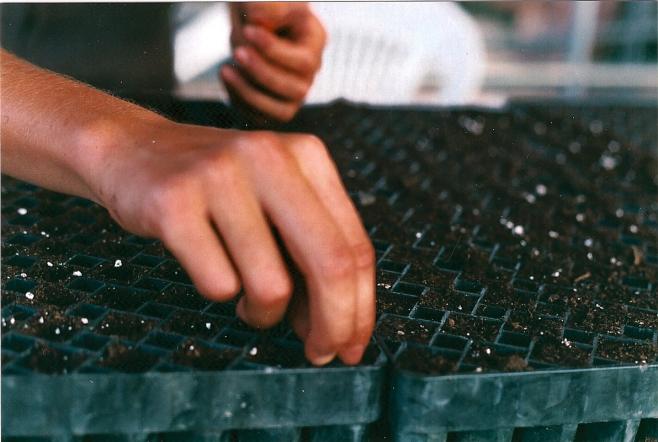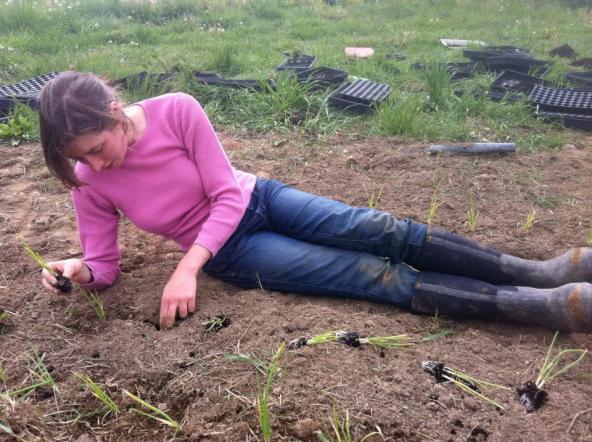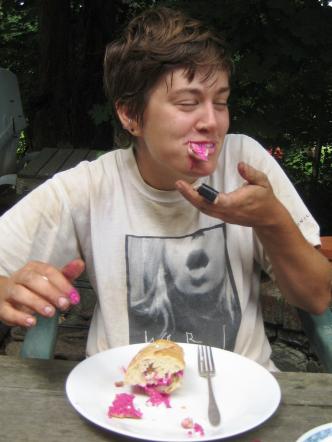This is the fifth post in a summer-long series from a young farmer working as a harvest crew leader at Gardens of Eagan. Check out previous posts, Laying New Roots, When Farmers Stay Dry, Building Farm Community, and Bringing in the Harvest.
“Dirt First,” that’s what we say at Gardens of Eagan, because building healthy and nurturing soil makes for a flourishing farm. Comprised not only of weathered rock and decomposing organic matter, soil plays home to a host of macro and micronutrients and a plethora of organisms from actinomycetes to earthworms, rhizobia to nematodes, arthropods to moles, creating what we call a soil community. Since soil is the basis of agriculture, caring for our dirt ensures that our bellies remain full. Though we often can’t see or just forget about what takes place underground – from rhizomes fixing nitrogen and forming nodules on legume roots to earthworms tunneling through compaction and trailing nutrient-rich castings behind them – the interconnected community below the soil makes possible the cultivation above.
---
 Kayla and me returning some decomposing nutrients (a dead opossum) to the soilLike
a baby, a tender young seedling, or an egg laid carefully in a nesting box,
healthy, living, and actively growing soil takes time to cultivate. Often
organic farms find homes on reclaimed, renamed pieces of land. Soil on new
organic farms tends to be sick from a constant stream of harmful chemicals, a
stunted crop rotation from soy beans to corn to soy beans, or a pile up of
thoughtlessly tossed trash, leaving farmers to nurse its heavily hung over,
haphazardly cultivated, and hungry acreage back to health. But unfortunately
two big cups of coffee and a plate of greasy eggs and toast fail to do the
trick. Remaking this aching land takes years – as well as a massive input of
important minerals and nutrients, an invitation for beneficial organisms, and a
constant effort to maintain a fluffy and well-aggregated tilth.
Kayla and me returning some decomposing nutrients (a dead opossum) to the soilLike
a baby, a tender young seedling, or an egg laid carefully in a nesting box,
healthy, living, and actively growing soil takes time to cultivate. Often
organic farms find homes on reclaimed, renamed pieces of land. Soil on new
organic farms tends to be sick from a constant stream of harmful chemicals, a
stunted crop rotation from soy beans to corn to soy beans, or a pile up of
thoughtlessly tossed trash, leaving farmers to nurse its heavily hung over,
haphazardly cultivated, and hungry acreage back to health. But unfortunately
two big cups of coffee and a plate of greasy eggs and toast fail to do the
trick. Remaking this aching land takes years – as well as a massive input of
important minerals and nutrients, an invitation for beneficial organisms, and a
constant effort to maintain a fluffy and well-aggregated tilth.
At Gardens of Eagan, we are currently focused on creating and maintaining the health of our newly purchased soil. We smattered our land with a mix of cover crops, plants grown to replenish soil nutrients, in both life and death, and showered it with warm, rich compost, in an effort to bring it back to life. Cover crops and compost work to mend the mindless, profit-driven efforts of conventional farming by building up top soil, reintroducing microorganisms, establishing soil structure, and pumping the land with a mix of nitrogen, phosphorus, and potassium.
This is our final year of extra intensive soil replenishment, where we add back the nutrients that mono-cropped corn and soy beans stripped away. By the end of July 2014 our land will be technically free from all hazardous chemicals employed by conventional agriculture; in other words, as deemed by the USDA, Gardens of Eagan, a 40 year-old certified organic farm, will once again yield exclusively organic produce.
 Seeding a wind strip at Jones Valley Urban Farm
Seeding a wind strip at Jones Valley Urban Farm
My most difficult days of farming I’ve spent working with the soil, tending the body of a farm, and working to make it whole. I remember building raised beds on the farm where my agricultural soul rooted, grew, and blossomed as the hardest work of my life. On a small three-acre city block in Birmingham, Alabama, as the late August sun forced a slump in my shoulders and a burn on my back, I raked concrete chunks from freshly tilled soil. From morning to mid-day I piled the remains of a parking lot, an old building’s cracking foundation, the steps of an abandoned apartment building into piles at my feet. And after lunch, one shovel full at a time, I threw the remnants of my crumbling city into a wheelbarrow and carted them off, to sleep at the edge of the fields, close enough to see the sunflowers pulling themselves up, into our world.
 Kayla lounging and planting scallions at Phillies Bridge Farm Project
Kayla lounging and planting scallions at Phillies Bridge Farm Project
Once the new beds rested, free of cumbersome concrete clumps, I hauled in loads of compost, laid it carefully on the red soil, and evenly mixed in the nutrient-dense, black humus with a hope of revitalization. In the seasons after, sometimes we grew more weeds than plants, sometimes the harlequin beetles clung tightly to our collards, sometimes our brassicas grew purple and yellow before a crown of broccoli or head of cabbage emerged, but we perservered and held on to our soil like a child clutches an ice cream cone, tight and intent, never allowing it to fall.
---
Soil clings to things, to sweet orange carrots released from the ground after the first frost, to the deep lines carved into the palms of my hands, to the fibers of our favorite t-shirts, worn carelessly into the fields; we carry it home, stuck in the crevices of our boots, smeared in Rorschach splatters on our shins and chins and forearms, speckled lazily between teeth, in our hair, along an ear canal or two. Its nutrients course through our bodies by way of delicious fruits and vegetables: trickling in through layers of lettuce, wedged in between the greens of scallions, clinging to the rumpled knobs of celeriac. Though we spend hours and sometimes days scrubbing our cucumbers, dunking our lettuce, spraying the roots of our garlic, I prefer my vegetables dirty – proof they once lived in the ground, sleeping with earthworms in the beds we’ve so carefully prepared.
Note: The title of this post – "Don't treat your soil like dirt" – comes from a bumper sticker distributed by the Intervale Center, an incubator farm project in Burlington, VT.

Katie Willis is a native of Birmingham, Alabama, where she grew up with NASCAR, twangs and drawls, and lots of fried okra. Her farming career began on an urban farm in Birmingham, where she ate arugula and swiss chard for the first time in her life. Eventually she moved to rural New York to work with chickens, goats, and really strong women. She enjoys a rowdy round of arm wrestling, discussions on all things related to heternormativity, seasonal food preservation, long bike rides, Toni Morrison, and ice-cold beer. Katie recently moved to the Twin Cities with her girlfriend, Lily. They live in Powderhorn and eat lots of butter, maple syrup, and frozen kale. This year marks her seventh season with soil underneath her fingernails and a bounty in her fridge. Her last post for SGT was Farm Journal: Bringing in the Harvest.

